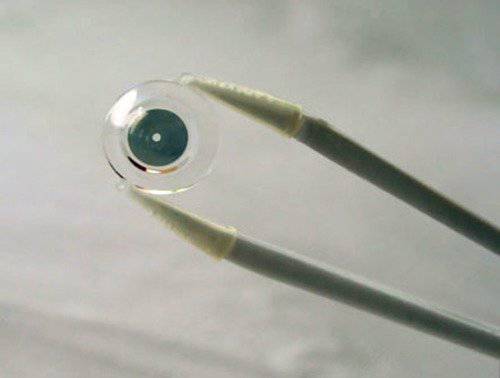Glasses and lenses for augmented reality

In the fantastic books and films there are special glasses, which displays all the necessary information. The creation of such systems is quite real - aircraft indicators on the windshield are proof of that - but in the case of glasses, there is a snag of anatomical nature. The distance between the eye and the glasses usually does not exceed 1,5-2 centimeters. The human eye is not able to focus the view at such small distances. The accommodation limit (the shortest possible focusing distance of the optical system of the eye) for most people is more than 10-12 centimeters. Accordingly, in themselves, glasses with a display are useless. Not so long ago, the American company Innovega presented its own solution to this biological problem. The development of iOptik is a “augmented reality system”. That is what the press release says.
As is clear from the description, in addition to glasses equipped with a display, a person must use a special contact lens. The lens is made bifocal - it has two optical zones with different refractive indices. Optical zones of the lens are “arranged” in the form of two concentric circles. Central, adjacent to the center of the pupil, by default has no optical power and allows a person to look freely in any direction and at any distance without any problems. If necessary, the central part of the iOptik contact lens can be corrected to correct visual impairment. The outer optical zone, in turn, has such a form that the rays from the screen on the glasses are redirected to the peripheral part of the pupil. Thus, a person can simultaneously look into the distance and see the information displayed by the glasses. The display glasses can display almost any text, digital or graphic data. The only restriction at the moment concerns the placement of the image on the screen. For normal perception, it must be within certain limits, otherwise some of the information will fall into the “zone of action” of the inner optical zone of the lens.
The current state of the iOptik project allows the user to have at the same time only two objects in view - the image on the glasses and something at a greater distance. Already, the development of the Innovega company with some modifications can be used by the military to facilitate the combat work of the soldiers. It is for this reason that gentlemen from the DARPA agency became interested in the iOptik system. In April of this year, DARPA and Innovega signed a contract, according to which the singer, represented by the company Innovega, can immediately begin the full development of a practically applicable device based on the iOptik project. No specific features of the agreement were made available to the public, but there are some scraps of information. Thus, the display of the “combat” version of iOptik will be made on the basis of standard US Army glasses. The electronic unit of the system responsible for the formation of the video signal will be combined with the GPS-navigator and some other electronics necessary for the fighter. In the future, the iOptik complex can be integrated into unified tactical communication and control systems. Moreover, the unit commander and his subordinates will receive exactly the information they need, depending on the situation and duties on the battlefield.
It should be noted that DARPA’s interest in the development speaks only of the military prospects of the iOptik system. But it can also interest civilian users. Currently, commercial versions of glasses and contact lenses are in full swing. The samples of civilian iOptik presented by Innovega consist of special contact lenses and glasses, additionally equipped with two miniature video cameras. Completes the picture a small box of the electronic unit. Thanks to cameras, a user can use glasses not only as an additional source of information from, say, a smartphone or tablet, but also as a compact and convenient binocular. The capabilities of the system, equipped with video cameras, allow you to “run over” to distant objects and get a picture of quite acceptable quality. A similar opportunity is likely to be on the military version of points.
At the end of the test, Innovega's management plans to obtain a patent for its invention, carry out all the necessary certifications and release the iOptik system to the civilian market. According to current plans, the first batch of iOptik civilians will be able to disperse among consumers as Christmas presents 2014 of the year. The military version will go to the tests in the 2015 year.
On the materials of the sites:
http://innovega-inc.com/
http:// wired.com/
http://mport.bigmir.net/
http://hitech.newsru.com/
Information